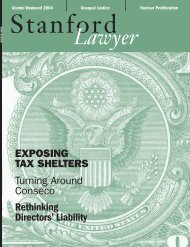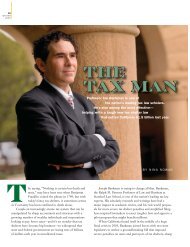of a whole variety of new mortgageinstruments, designed to adjust to orshift the risk of rate fluctuations.The legal issue thereby generated iswhether the terms of those instrumentswill be dictated more bymarket forces or by the regulatoryprocess in ways that impede theireffective use. The most sweepingargument for regulation of thedesign of alternative mortgage instrumentsis that lenders should notbe allowed to shift the risk of marketinterest rate increases to the borrower,who is less informed aboutsuch matters and less able to predicttheir future course. While it is nodoubt true that the average lender ismore sophisticated about financialmarkets than the average borrower,it is probably also true that theaverage mortgage borrower is betterhedged against inflation (through hissal~ry and real estate equity) thanthe typical S&L has been, and henceis the superior risk-bearer in thisinstance.The other arguments for regulationof mortgage instruments aremostly a familiar sort of consumerprotection rationale - a blend ofassumed consumer ignorance and afailure to recognize that the allocationof various risks in the contract isinevitably reflected in the priceterm. If the regulators were contentto place some sort of ceiling on theprepayment penalty, for example, itis hard to see how substantive regulationof the other areas of the contractcould be justified. But althoughflexibility in the design and evolutionof mortgage instruments is certainlydesirable, these issues probably donot impact institutional survival inany major way.The traditional S&L financed itsholding of a m.ortgage portfolio on abase of savings accounts, however,and here more problems are foreseeable.There is little specializedknowledge or skill needed to servicesavings accounts, and there arelarge-scale economies in storing theinformation and processing thetransactions. From the customer'sstandpoint, it is desirable to be ablequickly and cheaply to shift fundsamong different asset holdings andto access a secured line of creditwhenever needed. The broad-spectrumfinancial institution seems topossess substantial advantages overa savings specialist, at least for themore affluent customers who ownsecurities and write checks. But onlyabout 20 percent of adults ownstocks, and a significant fraction ofthe population still does not havechecking accounts. In competing forthe savings of this segment, broadspectrumofferings count for little.The savings specialist may still havea role, but it is a diminishing one.When the two functions of mortgagelending and savings receivingare combined in a single institution,additional difficulties emerge. Thedangers of short-term borrowingand long-term lending moved fromthe status of theoretical concerns toreal world nightmares in the 1970s,and of course adjustments weremade. New mortgage instruments ineffect shortened asset maturities,and new savings certificates lengthenedliability maturities. However, abalance has not yet been achieved.The thrifts have obtained constantlybroader lending and investment authority,which can also be used toproduce a shorter average maturityof assets. The Garn-St Germain Actof 1982 may have marked the culminationof that trend for the time being,with authority (albeit limited)for commercial as well as consumerlending, and for equipment leasing.But authorityis one thing, while itseffective exploitation is another. Asthrifts enter unfamiliar fields, whatcomparative advantages do theyhave over institutions already there?Are there production economies inadding general commercial lendingto real-estate lending, or a limitednumber of checking accounts to savingsaccounts? The answers are noteasy to discern.In short, the traditional savingsand loan association, with a mortgageportfolio supported by a savingsaccount base, does not seem agood candidate for survival. Even ifinflation stays down and mortgagerates decline toward what were onceconsidered normal levels, the competitivecircumstances of the pastwill not be restored.The Thrift Industryin the FutureIn what directions, then, may we expectthe thrift industry to evolve?There are a number of possibilities.Some institutions will join in the newfinancial conglomerates that areemerging. This process has beenunder way for some time, but it isnow accelerating: Citicorp, Sears,and Household International all ownsavings and loan associations. Someof the largest S&Ls may take thelead in making such combinationsand become nuclei to which otherservices are added. In either event,S&Ls have at present one great tacticaladvantage in the contest tocreate some nationwide financial institutions- they do not transformtheir parent companies into bankholding companies. That means theycan add other financial services,extend EFT networks (and evenbranches, if acquired in supervisorymergers) across state lines, largelyignore the Glass-Steagall Act byoffering securities services, and soon. This advantage is a legal artifactand may not be permanent, but it isof no small value while it lasts.What the geographic scale of thesenew financial conglomerates will beis not yet clear. Some will be nationalin scope, but others will probably beregional; the scale economies involvedare still being determined.But however much the IndependentBankers Association may pine forthe days of the local institution comfortablyprotected in its localmarket, the clock cannot be turnedback. That means that in the S&L14<strong>Stanford</strong> <strong>Lawyer</strong> <strong>Fall</strong> <strong>1983</strong>
usiness, as in banking, we have toomany small and separate institutions,and many will disappear. Itwould be better for all concerned ifthat occurred by voluntary and negotiatedmerger rather than by failureor receivership, but no doubt we willsee more of both. The mix betweenacquisitions and failures will bedetermined in part by the way thebanking agencies and the Departmentof Justice's Antitrust Divisioninterpret the Clayton Act stricturesagainst market concentration. Definitionsof banking markets have forthe past two decades been unrealisticallynarrow, following theSupreme Court's 1963 PhiladelphiaNational Bank decision, but thatmay now be changing, at least so faras the Department of Justice is concerned.Does this mean that only financialconglomerates will be viable in thefuture? Will all savings and loanseither meld into broad-spectrumfirms or vanish? That seems unlikely,but they will be transformedin major ways. Some will becomeconsumer banks, although for thatthey will need broader authoritythan they now have on both the assetand the liability side. At present,S&Ls are too constrained by percentage-of-assetsinvestment limitations(in both their charteringlegislation and the tax code) and byrestrictions on offering checking accountsand competing for funds. Theneeded authority may be obtained byfurther amendments of the law, orby conversion into other types offinancial institutions.Some S&Ls may move from beingfinancial intermediaries holdinglarge loan portfolios to beingprimarily mortgage bankers- originatingreal estate loans but sellingthem to pension funds and other institutionalinvestors or packagingthem into mortgage pools for sale tothe public. There are advantages toportfolio diversification, in terms ofreducing unnecessary risk, that aspecialized lender cannot achieve;but there are also advantages tospecialization in originating and servicing,particulartypes of loans. Onestrategy might be for some associationsto use a reduced base of savingsaccounts to carry, not an extensiveloan portfolio, but rather the inventoryof a dealer being held brieflybefore resale. In this manner, theultimate credit and market risk isborne by more diversified lenders.Another strategy might be for associationsto draw on their knowledgeof real estate to move into realestate development directly, a trendlong discernible in California and afew other states (although limited inamount). Real estate development isa much more risky line of businessthan secured lending, and the requiredequity capital is accordinglymuch more expensive. S&Ls would,therefore, have a competitive advantagein such pursuits if they alonecould raise funds at the lower ratescommanded by relatively riskless insureddeposits, reinvesting at thehigher rates associated with theequity interest in real estate development.That of course amounts totransferring the risk to the FederalSavings and Loan Insurance Corporation(FSLIC) and exploiting itsuniform premium system.The FSLIC is currently studyingthe possibility of varying its premiumaccording to an institution'srisk; but the risk FSLIC initially hadin mind appeared to be mostly themarket risk from an imbalance inasset and liability maturities, ratherthan the higher variance in returnsfrom activities like real estatedevelopment. To be of value, theFSLIC study must encompass notonly both those kinds of risk, butanother kind as well. The risk to theinsurance corporation is not simply adirect function of the portfolio risk ofthe firm, because the failure of afinancial institution is not an unmistakableevent, like an auto accidentor a flood. An S&L failure representsa judgment by a supervisoryagency to close the firm or force itout of existence. The insurer's risk ispowerfully affected by the supervisor'sdecision to foreclose orforbear, a decision that is not easilymodeled or assessed. In any event, itis good to see the idea of a risk-basedvariable insurance premium beingtaken seriously. Ten years ago, TomMayer and I made such a proposal*in a study done for the Hunt Commission,and at that time the ideawas regarded as so far out that theCommission disposed of it in asentence or two.(continued on p. 61)*Scott and Mayer, Risk and Regulation inBanking: Some Proposalsfor Federal Deposit InsuranceReform, 23 STAN. L. REv. 857 (1971).<strong>Fall</strong> <strong>1983</strong> <strong>Stanford</strong> <strong>Lawyer</strong>15
- Page 1 and 2: RFAll 1983VOL. 18, NO.1Heroin Optio
- Page 3 and 4: jah(e,oYCONTENTSSTANFORD lAWYEREdit
- Page 5 and 6: Business Law vs. Public Interest La
- Page 7 and 8: By John Kaplanjockson Eli ReynoldsP
- Page 9 and 10: maintenance almost entirely up toth
- Page 11: smaller percentage of British addic
- Page 14 and 15: that, because of regulation, cannot
- Page 18 and 19: ConversationsWith Five AlumniBy Mic
- Page 20 and 21: y landlords and tenants about rents
- Page 22 and 23: when I was studying law and she was
- Page 24 and 25: ~o(1)AtISSUE *Union 'Rights' in the
- Page 26 and 27: AtISSUECongressional Responses toSu
- Page 28 and 29: AtISSUEPrison Labor:TimeTo Take Ano
- Page 30 and 31: Graduates and friends of theSchool
- Page 32 and 33: ~o~ 4'-VVcYi~STATE OF THE SCHOOLJoh
- Page 34 and 35: ~o~ Cff-VIMtu'0r-STATE OF THE SCHOO
- Page 36 and 37: ~o~ 4-(/141~STATE OF THE SCHOOL con
- Page 38 and 39: ~o~4VJ41~SUCCESSFUL LAWYERING:IMPLI
- Page 40 and 41: ~o~of-VJM~SUCCESSFUL LAWYERING cont
- Page 42 and 43: @.oarcA 4l!141~THE CONSTITUTION, RA
- Page 44 and 45: @o~4t1J41~.LAW AND BUSINESS PROGRAM
- Page 46 and 47: @otwrA 4vJ41~ .SUMMARY AND ADVISORY
- Page 48 and 49: David L. Engel(Harvard, JD '73)Bost
- Page 50 and 51: New Faculty (cont.)Michigan Law Sch
- Page 52 and 53: GILSON (cant.)Gilson is currently p
- Page 54 and 55: BabcockAwarded anHonorary LL.D.by S
- Page 56 and 57: CAREER 'ALTERNATIVES' (cant.)2. A s
- Page 58 and 59: Hurlbut WinnerTalks AboutTeachingPr
- Page 60 and 61: Schod;NI Grads Scatter toCities All
- Page 62 and 63: FACULTV NOTES (cant.) Professor Gun
- Page 64 and 65: it will be less so if we adopt a he
- Page 66 and 67:
than on its edges, thus increasing
- Page 68 and 69:
Heroin maintenance is, in manyways,
- Page 70 and 71:
c~OTESII1912-25Hon. David Lee Rosen
- Page 72 and 73:
c~NOTESthe firm advises, that "Donn
- Page 74 and 75:
c~NOTESand had been prominent in a
- Page 76 and 77:
spring Dean Ely traveledLEast, wher
- Page 78 and 79:
5Stanford LaWlers:This Page IsYours
- Page 80 and 81:
October 11Washington, DC LawSociety
- Page 82 and 83:
COMPARATIVE CONTRIBUTIONS TOTHE LAW
- Page 84 and 85:
A MESSAGE FROM THELAW FUND PRESIDEN
- Page 86 and 87:
CLASSAGENTSLong BeachSterling S. Cl
- Page 88 and 89:
Warren Christopher'49 Penny Howe Ga
- Page 90 and 91:
Frank L. Mallory '47Richard C. Mall
- Page 92 and 93:
Ronald G. Trayner '67Anthony J. Tre
- Page 94 and 95:
Walter A. Johnson, A.B. '29 Maxine
- Page 96 and 97:
DONORS TO THE LAW FUND• Hon. Murr
- Page 98 and 99:
CLASS OF 1948R. Winfield AchorHon.
- Page 100 and 101:
• Thomas R. MitchellR. Chandler M
- Page 102 and 103:
Paul E. Kreutz• Prof. Richard B.
- Page 104 and 105:
Gabriel M. GesmerMichael GilfixCorn
- Page 106 and 107:
HIGHEST LEVELSOF PARTICIPATIONLARGE
- Page 108 and 109:
FACULTY, FORMERFACULTY &STAFFBarbar
- Page 110 and 111:
REUNION GIVINGWhile class reunions
- Page 112 and 113:
DONORS TO SPECIALPROGRAMS AND FUNDS
- Page 114 and 115:
Class of 1954 Reunion Student Finan
- Page 116 and 117:
In Memory of:Clifton C. Cottrell '2
- Page 118 and 119:
Clyde E. Tritt'49William W. VaughnS
- Page 120:
BEQUESTS AND DEFERRED GIVINGBequest
















